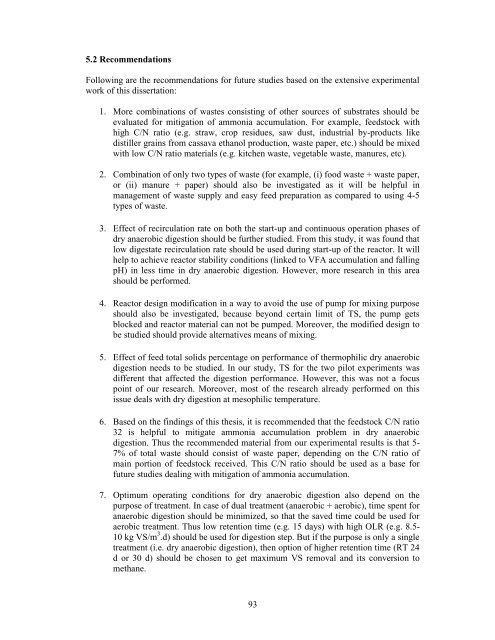dry anaerobic digestion of municipal solid waste and digestate ...
dry anaerobic digestion of municipal solid waste and digestate ...
dry anaerobic digestion of municipal solid waste and digestate ...
Create successful ePaper yourself
Turn your PDF publications into a flip-book with our unique Google optimized e-Paper software.
5.2 Recommendations<br />
Following are the recommendations for future studies based on the extensive experimental<br />
work <strong>of</strong> this dissertation:<br />
1. More combinations <strong>of</strong> <strong>waste</strong>s consisting <strong>of</strong> other sources <strong>of</strong> substrates should be<br />
evaluated for mitigation <strong>of</strong> ammonia accumulation. For example, feedstock with<br />
high C/N ratio (e.g. straw, crop residues, saw dust, industrial by-products like<br />
distiller grains from cassava ethanol production, <strong>waste</strong> paper, etc.) should be mixed<br />
with low C/N ratio materials (e.g. kitchen <strong>waste</strong>, vegetable <strong>waste</strong>, manures, etc).<br />
2. Combination <strong>of</strong> only two types <strong>of</strong> <strong>waste</strong> (for example, (i) food <strong>waste</strong> + <strong>waste</strong> paper,<br />
or (ii) manure + paper ) should also be investigated as it will be helpful in<br />
management <strong>of</strong> <strong>waste</strong> supply <strong>and</strong> easy feed preparation as compared to using 4-5<br />
types <strong>of</strong> <strong>waste</strong>.<br />
3. Effect <strong>of</strong> recirculation rate on both the start-up <strong>and</strong> continuous operation phases <strong>of</strong><br />
<strong>dry</strong> <strong>anaerobic</strong> <strong>digestion</strong> should be further studied. From this study, it was found that<br />
low <strong>digestate</strong> recirculation rate should be used during start-up <strong>of</strong> the reactor. It will<br />
help to achieve reactor stability conditions (linked to VFA accumulation <strong>and</strong> falling<br />
pH) in less time in <strong>dry</strong> <strong>anaerobic</strong> <strong>digestion</strong>. However, more research in this area<br />
should be performed.<br />
4. Reactor design modification in a way to avoid the use <strong>of</strong> pump for mixing purpose<br />
should also be investigated, because beyond certain limit <strong>of</strong> TS, the pump gets<br />
blocked <strong>and</strong> reactor material can not be pumped. Moreover, the modified design to<br />
be studied should provide alternatives means <strong>of</strong> mixing.<br />
5. Effect <strong>of</strong> feed total <strong>solid</strong>s percentage on performance <strong>of</strong> thermophilic <strong>dry</strong> <strong>anaerobic</strong><br />
<strong>digestion</strong> needs to be studied. In our study, TS for the two pilot experiments was<br />
different that affected the <strong>digestion</strong> performance. However, this was not a focus<br />
point <strong>of</strong> our research. Moreover, most <strong>of</strong> the research already performed on this<br />
issue deals with <strong>dry</strong> <strong>digestion</strong> at mesophilic temperature.<br />
6. Based on the findings <strong>of</strong> this thesis, it is recommended that the feedstock C/N ratio<br />
32 is helpful to mitigate ammonia accumulation problem in <strong>dry</strong> <strong>anaerobic</strong><br />
<strong>digestion</strong>. Thus the recommended material from our experimental results is that 5-<br />
7% <strong>of</strong> total <strong>waste</strong> should consist <strong>of</strong> <strong>waste</strong> paper, depending on the C/N ratio <strong>of</strong><br />
main portion <strong>of</strong> feedstock received. This C/N ratio should be used as a base for<br />
future studies dealing with mitigation <strong>of</strong> ammonia accumulation.<br />
7. Optimum operating conditions for <strong>dry</strong> <strong>anaerobic</strong> <strong>digestion</strong> also depend on the<br />
purpose <strong>of</strong> treatment. In case <strong>of</strong> dual treatment (<strong>anaerobic</strong> + aerobic), time spent for<br />
<strong>anaerobic</strong> <strong>digestion</strong> should be minimized, so that the saved time could be used for<br />
aerobic treatment. Thus low retention time (e.g. 15 days) with high OLR (e.g. 8.5-<br />
10 kg VS/m 3 .d) should be used for <strong>digestion</strong> step. But if the purpose is only a single<br />
treatment (i.e. <strong>dry</strong> <strong>anaerobic</strong> <strong>digestion</strong>), then option <strong>of</strong> higher retention time (RT 24<br />
d or 30 d) should be chosen to get maximum VS removal <strong>and</strong> its conversion to<br />
methane.<br />
93

















